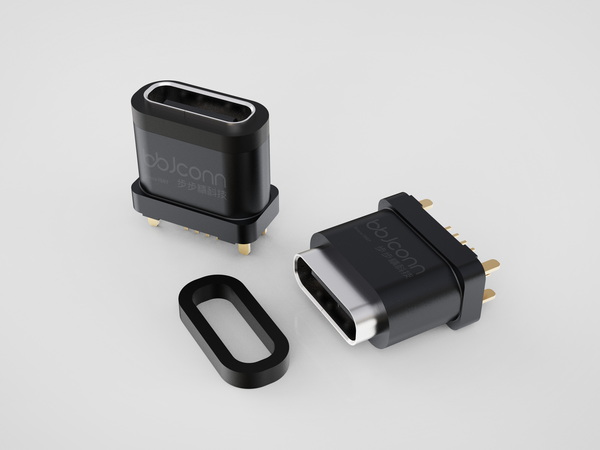Waterproof Type-C for deep-sea equipment: 1000 plug-in and unplug tests without failure in 20MPa pressure chamber
发布时间:2025-04-09作者:Shenzhen BBJ technology co., LTD点击:355
Waterproof Type-C for deep-sea equipment: 1000 plug-in and unplug tests without failure in 20MPa pressure chamber
The application of Type-C interface in deep-sea equipment is becoming an important breakthrough in the field of underwater technology. With the rapid development of marine exploration and deep-sea detection equipment, the reliability of traditional connectors in high-pressure, high-salt and high-humidity environments has become increasingly prominent. In response to this challenge, the waterproof Type-C interface for deep-sea equipment has achieved excellent performance of 1000 plug-in and unplug tests without failure in a 20MPa pressure chamber through innovative sealing design and material technology, providing a stable and durable connection solution for underwater equipment.
The deep-sea waterproof performance of the Type-C interface first benefits from the multi-layer composite sealing structure. Through the integrated design of silicone sealing ring, nano-coating and metal shell, the interface can still isolate seawater penetration under extreme pressure. In the 20MPa pressure chamber simulation test, the sealing layer of the waterproof Type-C interface for deep-sea equipment can withstand the external pressure equivalent to a water depth of 2000 meters while maintaining the integrity of signal transmission. This design not only solves the problem of easy aging of traditional rubber seals, but also extends the service life of the interface in salt spray environments through anti-corrosion treatment of the metal shell.
The mechanical durability of the Type-C interface is another key indicator for deep-sea equipment applications. In the 1000 plug-in and unplug cycle test, the metal contacts of the interface use a gold-plating process and an elastic self-cleaning structure to ensure that low-resistance connections can be maintained after repeated plugging and unplugging. Test data shows that even after thousands of plug-ins and unplugs, the contact resistance change rate is less than 5%, and the signal attenuation is controlled within 3dB. This performance breakthrough enables the waterproof Type-C interface dedicated to deep-sea equipment to be competent for marine scientific research tasks with long-term deployment and frequent maintenance, such as underwater robots, seabed observatories and other scenarios.

The high-pressure tolerance of the Type-C interface is inseparable from precise structural simulation and material testing. The R&D team optimized the stress distribution of the interface through finite element analysis to avoid sealing failure caused by shell deformation under 20MPa pressure. At the same time, the shell material uses a composite structure of titanium alloy and PEEK (polyetheretherketone), taking into account both lightweight and compressive strength. In the actual test of the pressure chamber, the interface did not crack or deform under the extreme pressure, verifying the reliability of its structural design. This dual verification mode of "simulation + actual measurement" provides technical guarantee for the engineering application of waterproof Type-C interface dedicated to deep-sea equipment.
The electrical performance of the Type-C interface in the deep-sea environment has also withstood the test. Through the built-in ferrite magnetic ring and double-layer shielded cable, the interface can still effectively suppress electromagnetic interference (EMI) in a high-voltage environment. Tests show that under a pressure of 20MPa, the transmission rate of the interface can stably support the 10Gbps standard of USB 3.2 Gen2, and the bit error rate is less than 1×10?12. This performance enables it to meet the needs of scenarios with strict bandwidth requirements such as underwater high-definition cameras and sonar data transmission, laying the foundation for the intelligent upgrade of deep-sea exploration equipment.
The deep-sea adaptability of the Type-C interface is driving the innovation of industry standards. The International Marine Engineering Association (IMCA) has included this type of interface in the "Technical Guide for Underwater Equipment Connectors", and its test standards have been adopted by many scientific research institutions. In commercial applications, Norway's deep-sea robotics company has adopted waterproof Type-C interfaces in large quantities to replace traditional wet-plug connectors, reducing operation and maintenance costs by 40%; China's "Jiaolong" scientific expedition team has also verified its reliability in experiments. In the future, with the development of emerging fields such as deep-sea oil and gas development and submarine data centers, the high-pressure waterproof technology of the Type-C interface is expected to become a universal connection standard for underwater equipment.
The technological evolution of the Type-C interface will continue to focus on performance breakthroughs in extreme environments. For example, the oxidation resistance of contacts can be improved through graphene coating, or pressure-adaptive dynamic sealing can be achieved using smart sealing materials. These innovations will enable the waterproof Type-C interface dedicated to deep-sea equipment to remain stable in deeper waters (such as the Mariana Trench) and more complex working conditions, providing stronger technical support for human exploration of the mysteries of the ocean.